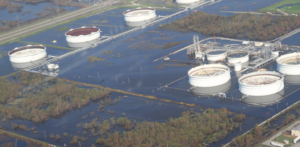
Hurricane Ida may have slipped from the news, but its deadly legacy continues, and in some communities the extent of the lasting damage is only now becoming apparent.
There is increasing evidence of how badly the Hurricane impacted the vast fossil fuel infrastructure of the region – ranging from offshore rigs to onshore petrochemical plants.
As of last week, the Coast Guard had responded to more than 2,200 reports of pollution in the region since Ida struck. Hundreds of spills are yet to be investigated, though.
Inland there are other spills along the Mississippi River, linked to broken oil tanks and flooded refineries.
The damage is a stark reminder of just how vulnerable much of the existing oil and gas infrastructure is to our increasingly violent and unpredictable weather.
There is also huge amount of pollution in coastal areas linked to old infrastructure. “A lot of the pictures I’ve seen [of Ida spills] are in coastal areas where there’s a lot of old infrastructure,” Don Boesch, a Professor of Marine Sciences at the University of Maryland told NOLA. “That indicates a background question of longer-term contamination.”
Boesch added that the Louisiana marshes already have unusually high concentrations of oil due to “the chronic effect” of frequent spills and seeps from aging wells and pipelines. These are then re-released with the storm surge that comes with a hurricane like Ida.
And that is the problem with storms hitting areas that are already chronically polluted by decades of indifference and regulatory failure or capture.
Many of the worst hit communities are those already fighting decades of pollution and injustice from the fossil fuel industry, especially those in the infamous Cancer Alley, the 85-mile stretch of the Mississippi River between New Orleans and Baton Rouge. Dozens of communities along Cancer Alley are already suffering lack of basic services, such as clean water and adequate sanitation.
They are already suffering the consequences of rampant pollution. As the scientific journal Nature pointed out, U.S. Environmental Protection Agency data in the region reveals that cancer risks in predominantly Black areas in some parishes are 1.7 times higher those of predominantly white areas. It is then no wonder, that the United Nations stated the region exemplified environmental racism.
As Catherine Coleman Flowers so eloquently states in the Nature article: “Advocates often talk about social justice, political justice, environmental justice, climate justice and more as though they are separate issues. The fact is: inequalities overlap and amplify each other. Those bearing the brunt of climate change often have the fewest resources and the most constraints on their civil rights, and live in the most polluted places.”
In the aftermath of Hurricane Ida, the civil society organization Healthy Gulf documented the damage in Cancer Alley, as well as other parishes in Louisiana. Flying over the worst affected area, Healthy Gulf documented the “catastrophic damage to the communities and industries that bore the brunt of Hurricane Ida’s wrath.”
According to Scott Eustis, from Healthy Gulf, the “air pollution was rampant” on their trip, while on the ground refineries and petrochemical facilities were “drowning in water,” with many facilities showing damage to their tanks or buildings.
“The observations were tragic and predictable” wrote Eustis. “Entire communities were flooded, multiple oil slicks were observed and reported, petrochemical facilities were flaring and spewing black smoke into the air next to Black and brown communities.”
Indeed, it was reported that in the weeks since Hurricane Ida, oil refineries and petrochemical plants along Cancer Alley were “flaring at full blast,” with many monitoring stations out of service.
“Seeing this devastation first-hand is yet another reminder that we are woefully unprepared for the continuing climate crisis,” concluded Eustis.
One particularly hard-hit community is that of St. James Parish, located in the heart of Cancer Alley. Rolling Stone interviewed Sharon Lavigne, who was recently awarded the Goldman Environmental Prize for her work as founder and director of RISE St. James, campaigning against the toxic oil industry.
Lavigne told our wonderful former colleague, Antonia Juhasz, now writing for Rolling Stone magazine, how she had “watched crude oil spill out of a holding tank, seen flares shoot fire out of a petrochemical plant, and smelled a foul chemical stench from a fertilizer manufacturer.”
Lavigne believes that the amount of damage caused by the fossil fuel industry in the wake of Hurricane Ida in “the form of oil spills, leaks, chemical releases, ruptures, and more, could dwarf the impacts of any previous storm system.”
Lavigne, whose own home was badly damaged by Ida, told Rolling Stone, “I worry about people getting [even more] sick, that’s what I worry about.” Given Ida’s toxic legacy it is no wonder that Lavigne and so many others are worried and are demanding change from their elected leaders. This cycle of pollution cannot be allowed to continue.
For anyone interested in donating to communities on the Cancer Alley frontline, click here.
There is also a GoFundMe page to help Sharon Lavigne rebuild her house.

